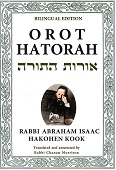
“If a man strikes his male or female slave with a rod, and the slave dies under his hand, the death must be avenged [the master is punished by death]. However, if the slave survives for a day or two, his death shall not be avenged, since he is his master’s property.” (Exodus 21:20-21)
The Torah portion of Mishpatim deals primarily with laws governing society — personal damages, lending money and articles, manslaughter, kidnapping, and so on. Overall, they fit in well with a modern sense of justice. The laws dealing with slaves, however, are difficult for us to digest.
His Master’s Property
Slavery, Rav Kook explained, is like any other natural phenomenon. It can be used properly and responsibly, or it can be abused. As long as some people are wealthy and powerful, while others are poor and weak, the wealthy will hire out the poor to do their labor and will control them. This is the basis of natural servitude, which exists even if slavery as a formal institution is outlawed.
For example, coal miners are de facto slaves to their employer, and in some ways worse off than legal slaves. The mine owner often cares more about his profits than his workers. He allows his miners to work without proper light and ventilation, in poorly built mines. The owner is not perturbed that his workers’ lives are shortened due to their abysmal working conditions. He is not overly troubled that the mine may collapse, burying alive thousands of miners — he can always hire more.
Yet, if these miners were his legal slaves for whom he paid good money, then the owner would look out for their lives and welfare just as he watches over his machines, animals, and the rest of his property. For this reason, the Torah emphasizes that a slave is his master’s property. When it is in the master’s self-interest to look after his slave’s welfare, the servant can expect a better, more secure future.
Why does the Torah distinguish between a slave who dies immediately after being struck by his master, and one who lingers for a day? The verse specifically mentions that the master struck with a rod, an indication that his intention was not to harm the slave, but to discipline him. If the slave dies due to mistreatment at the hands of his master, we take into account the natural concern that all people have for their possessions. The Torah rules that no death penalty is incurred, “since he is his master’s property.” In these circumstances, intentional murder becomes improbable, and the Torah looks for an additional factor — a non-immediate death — to indicate that the death was accidental. The Torah stresses that the goal is to serve justice, not to avenge. Thus the unusual phrasing, “his death shall not be avenged.”
The Institution of Slavery
The legalized slavery of the Torah only comes to correct certain potential pitfalls of the natural phenomenon of slavery. As long as slavery exists, the Torah legislated laws to protect slaves from abuse and mistreatment. If an owner knocked out his slave’s tooth, or caused the loss of any other limb, the slave went free. An owner who killed his slave was executed, like any other murderer.
Since the destruction of the Temple, however, the Torah’s positive influence upon general society has greatly weakened. The darkness of the Middle Ages severely corrupted natural forms of life, transforming slavery into a monstrous institution. Instead of protecting the weak by giving them the security of property, slavery became such a horror that humanity decided it needed to be permanently outlawed.
The Torah’s form of servitude must be set aside, until the era when, once again, “Torah will go forth from Zion.” At that time, servitude will provide not only financial security, but also moral and spiritual mentorship.
When the heart has once again become a sensitive vessel of integrity and compassion, it is fitting that the morally deficient should be taken under the wings of those righteous and wise.
(Gold from the Land of Israel, pp, 139-141. Adapted from Igrot HaRe’iyah vol. I, Letter 89, pp. 95-98)
Illustration image: ‘A Man Interfering in a Street Fight’ (Francisco Goya, 1812–20)





